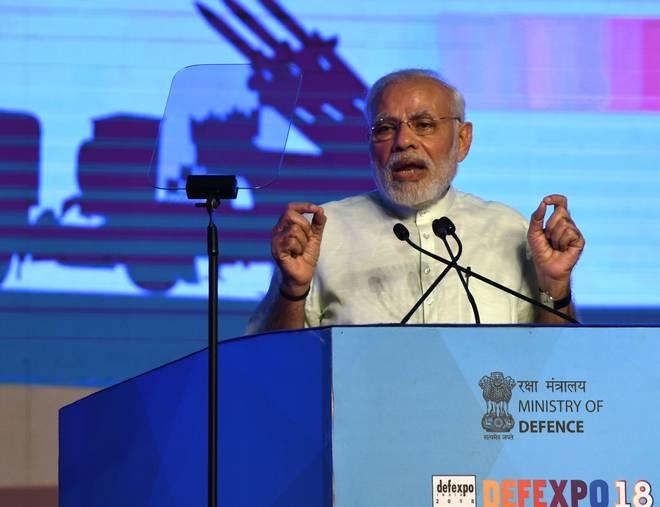Defence: Once Burnt Twice Shy

Image Courtesy: The Hindu
At the 10th edition of DefExpo held in Chennai on April 12, Prime Minister Narendra Modi tried to cover the failure of his government in the military sector and the rhetoric of turning India into a military manufacturing hub with rousing words on how his government has done better than Congress in ten years. However with a strike rate of 8-10% of 144 projects approved fructifying in last three years and a measly Rs 1.17 cr of Foreign Direct Investment there’s not much to show by way of anything new. The controversial purchase of 36 Rafales fighter jets at an exorbitant price and the deal to buy 1,86,000 bullet proof jackets somehow do not inspire confidence. For instance, contrast the claim made in 2015 during the Aero India show where the PM had famously claimed that in five years India’s dependence on imported weapons would be reduced from 70% to 40%. In four years there’s been no shift in this ratio or reduction in dependence on imports.
So it was what Defense Minister Nirmala Sitharaman said a day before which invites attention. Speaking on April 11 she pointed out that the government cannot cross the “thin line” in preventing the military from “making their decisions on what they want, what combination of the equipment they want, and in that combination if an Indian produced item fits in”. At first glance this seems non-controversial. But what she said is troublesome because of the context and place where she happened to be, namely an event which was hyped up to display Indian defense products for export. Up until recently the BJP government had been chasing the Foreign Direct Investment route, with an Indian corporate house, for defense product manufacturing. They had virtually nothing to show after four years of this exercise. During this entire phase a concerted campaign was carried out to run down the public sector defense sector. Military officials complained incessantly about the public sector military products and Indian Army lambasted the Ordinance Factory Board for inability to even produce rifles. They had also problems with Arjun Tanks, and Air Force showed tepid enthusiasm for Tejas light combat aircraft.
However, as part of a buildup for DefExpo a propaganda blitz ensued. It was claimed by officials of Ministry of Defense that they aim to achieve a turnover of Rs 1,70,000 cr ($26 billion) in military goods and services by 2025. In 2016-17 the total value of domestic defense production was Rs 55,894 cr. In 2013-14 it was worth Rs 43,746 cr so in two years it has risen modestly. Draft Defense Procurement Policy expects Rs 70,000 cr investment and to achieve export valued at Rs 35,000 cr ($5 billion) by 2025. In 2016 Sitharaman’s predecessor Manohar Parrikar, had boasted taking exports from $330 mn to $2 billion by 2019. Even then this claim looked unrealistic as it does now when it has been raised to $5 bn by 2025.
Now why would any country be interested in buying Indian military goods when the Indian military itself expresses such a low opinion about the public sector and the military goods produced by them? If the MoD cannot convince the Indian military to settle for military goods manufactured by DPSUs and OFBs then how does it intend to encourage foreign countries to buy the same? It is Boeing, an US OEM, which reposes more faith in HAL than Indian Air Force, though Government of India ensured that HAL was kept out of Rafale deal. Boeing has signed an agreement with HAL and Mahindra Group to manufacture its Super Hornet twin engine fighter jet if it lands the order for 57 Hornets for Indian Navy and 110 jets for IAF.
The point is not to welcome Boeing tying up with HAL. Because any military tie up with US is a minefield as it requires that India become part of US imperial orbit. Having signed Logistics Exchange Memorandum of Agreement in August 2016 India is being encouraged to now sign two other “foundational pacts” namely Communication Interoperability and Security Memorandum Agreement and Basic Exchange and Cooperation Agreement. The argument is that these would enable transfer of technology and also because this is a requirement under US law to protect US proprietary technology. Fact of the matter is that these pacts are “intrusive” and the two pending pacts would provide US personnel access to military bases and assets and their personnel will install, maintain and inspect equipment covered by these Pacts. Far greater concern is that when a foreign OEM offers to come and produce in India they want firm long term orders. Besides, Request for Information itself requires a year or two before the next step of Request for Proposal is made and then begins the grueling task of price negotiation. In other words we are few years away from the deal being struck.
Now it is true that having issued a request for Information for 110 fighter jets, single or double engine, the entire process which took place earlier in 2007 with MMRCA is revived with some tweaking of specification. But the MoD officials insist it’s a “fresh start” because the numbers are somewhat different: 15% of 110 to be imported and rest manufactured in India; and invite offers from fighter jets with single or double engine. But words do not make up for time lost or make ‘fresh start’ any more attractive. Especially when a near done deal was cancelled and a new process now begun from scratch.
Having said this, what four years have shown is that diminution of public sector military production does not pay. Defense officials, after beating the drum for privatization speak of not letting the “expensive infra-structure and trained manpower” of defense public sector go waste. And when they now speak of “level playing field” they no longer refer to enable FDI & private sector entry into military sector but to ensure that interest of public sector units do not suffer. How this shift will translate into real life when decisions are made remain to be seen. We have been here before when much was promised but little came of it.
Get the latest reports & analysis with people's perspective on Protests, movements & deep analytical videos, discussions of the current affairs in your Telegram app. Subscribe to NewsClick's Telegram channel & get Real-Time updates on stories, as they get published on our website.























